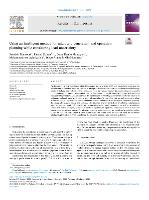Abstract
The integration of distributed generation (DG), energy storage systems (ESS), and controllable loads near the
place of consumption has led to the creation of microgrids. However, the uncertain nature of renewable energy
sources (wind and photovoltaic), market prices, and loads have caused issues with guaranteeing power quality
and balancing generation and consumption. To solve these issues, microgrids should be managed with an energy
management system (EMS), which facilitates the minimization of operating (performance) costs, the emission of
pollutants, and peak loads while meeting technical constraints. To this effect, this research attempts to adjust
parameters by defining indicators related to the best possible conditions of the microgrid. Generation planning,
the storage of generated power, and exchange with the main grid are carried out by defining a dual-purpose
objective function, which includes reducing the operating cost of power generation, as well as the pollution
caused by it in the microgrid, by means of the SALP optimization algorithm. Moreover, in order to make the
process more realistic and practical for microgrid planning, some parameters are considered as indefinite values,
as they do not have exact values in their natural state. The results show the effect of using the introduced
intelligent optimization method on reducing the objective function value (cost and pollution).














